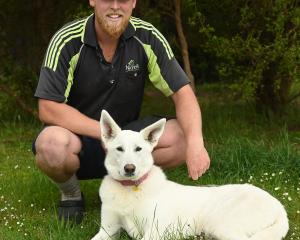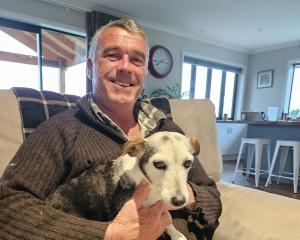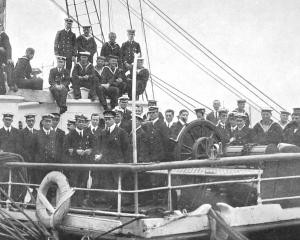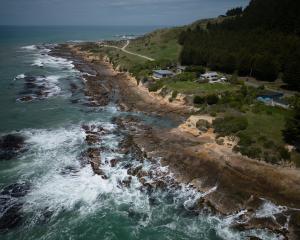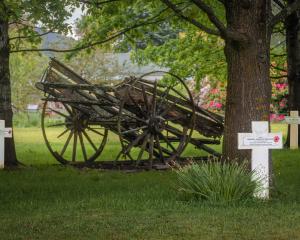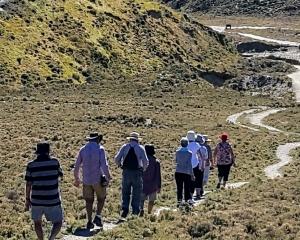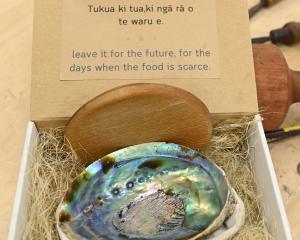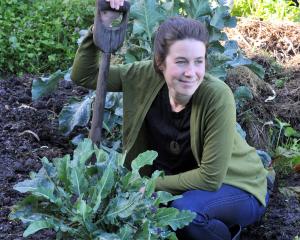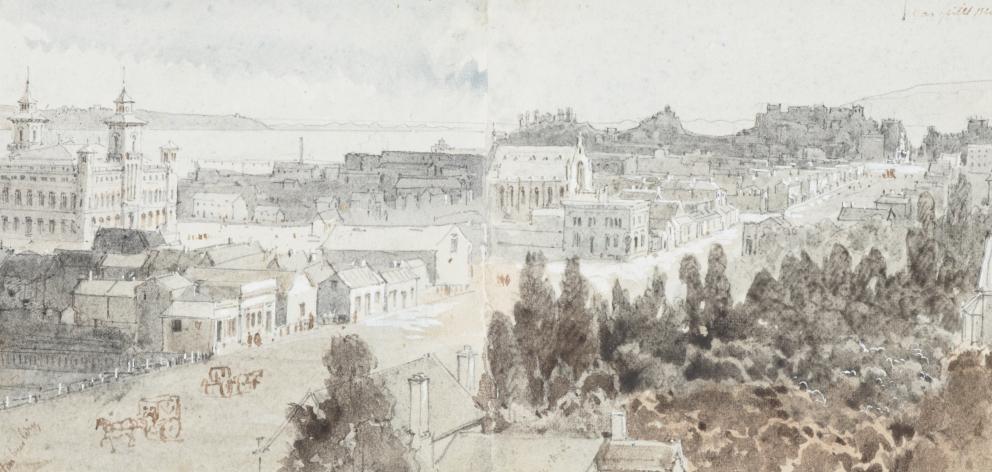
Kaikorai Valley, Green Island, Forbury Heights to Caversham.
The weather on Saturday being bright and clear, we determined on having another ramble; so leaving "The Nook" about 1pm, we proceed along that part of Queen street north which has been such a bone of contention of late at Town Board meetings; premising that, with all their noise, there can be no doubt of its being a great improvement.
Turning to the right at the top of Regent Road, we enter the gully, passing "Cosey Dell" and a number of equally cosily situated residences.
A short way up and the Town Belt is reached; here, alas! like many other parts, being rapidly denuded of all the burnable trees.
It is a great pity this should be allowed.
There is little doubt the time will come when the absence of trees will be deeply regretted, and the Government or the Corporation be petitioned for grants of money to replant the ground.
It is not as if it were poor people who are guilty of this practice, but people who can well afford to purchase all they require may be seen almost daily cutting down trees, and making boast of never having bought a stick of firewood since they came to the place.
We have only to point to that part of the Belt between Queen street north and Maori Hill in proof of this.
But what is everybody’s business is nobody’s business. Let us to our walk. On clearing the Belt, the road emerges on the open, close to the residence of H. Driver, Esq., having Maori Hill on our right.
Our steps are then directed towards the district road that passes along the ridge of the hill which backs the town, proceeding over some fine land, now being ploughed for the first time.
From its elevated position and the fine prospect by which it is surrounded, this road seems destined, at no distant date, to be lined with villas and seats.
We soon reach the neighborhood of the Shepherd’s Arms, passing the various sale-yards belonging to the cattle dealers in town, the City Company’s abbatoir, etc.
After passing these the road ascends, till a little way beyond Roslyn we arrive at the summit, about 800 feet over the tide.
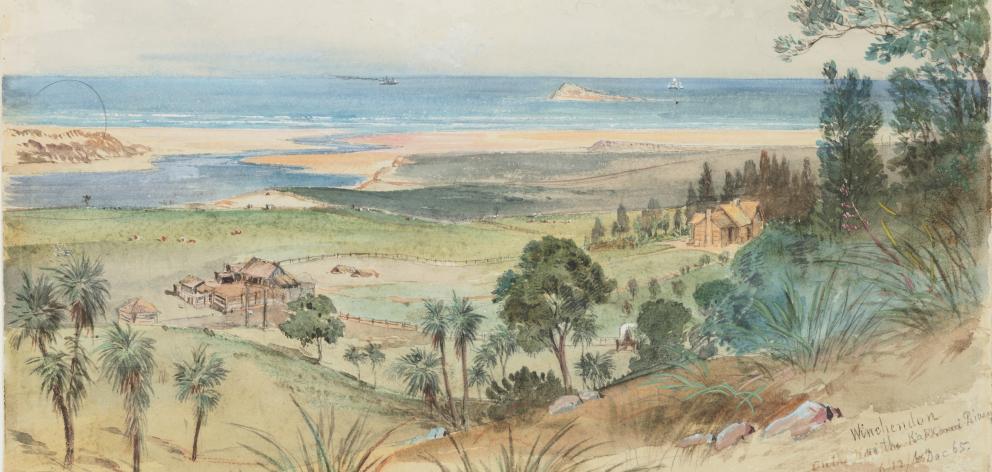
These blocks cover a large patch right on the hill-top, and are evidently lying in situ, and part of the same bluestone ridge which crops out here and there all the way from the Water of Leith to Caversham.
These stones command a most extensive view, which comprises on one side the Harbor, the Town and all the district eastward; while the other commands the Kaikorai Valley, Halfway Bush, Flagstaff, and so on, right off to the sea at the Taieri.
From thence, our way lies to the south, towards Richmond and Primrose Hill.
Still keeping to the ridge, on nearing these places, we take the right-hand road down into the valley, crossing the stream at Barr’s farm, where the Volunteer Butts are erected.
Here we find a large party of the various corps of Volunteers practising at the 500 yards range.
Adjutant Graham is in charge of the party, and some very good shooting is made while we are looking on. In order to get out of the line of fire, we recross the stream, and proceed down the eastern bank.
In crossing a paddock here we bag as many mushrooms as will make a quart of ketchup.
There are several spots on the banks of the Kaikorai Creek where mills might be very easily established, were there only trade for them; there being a plentiful supply of water and a good fall — all meantime running to waste.
After a short walk over some rough ground, we emerge on the Main South Road, which we keep till King’s Kaikorai Mills are reached, and then leave the Main Road by the Green Island district road, which runs seaward from this point.
A short way on we cross the creek by a neat footbridge, and then pass a fellmongery establishment, where we see some very fine looking wool undergoing the washing process.
Just below this the Kaikorai loses itself in a number of large shallow pools, owing their existence perhaps to the accumulation of sand at the mouth, where it is drifted up by the winds and waves.
On the side of the hill to the left of the road, there are a number of very pleasantly situated houses and farms, away in recesses among the trees.
This being a favorite locality with the early settlers, the countryside has an older and more cultivated look than is usual.
After proceeding along this road for about a couple of miles, the sand hills bounding the beach are reached, and then the road makes a sharp turn, rising considerably, and enters the bush.
From a point, just at the turn, a singular view is had. In front lies a bare bleak-looking expanse of brown hills, with numerous pools of water all along their base.
On that side there being no bush, except on the towering boss of Saddle Hill; while the hills on the eastern side are covered to the top with thick heavy bush.
A long range of coast is visible from this point; but walking over the wide sandy hills or dunes being very heavy, we did not go down to the beach.
The embouchure of the Kaikorai is the site of a township (Brighton), which has been advertised as a watering-place, and pushed at land sales by fine maps and views; but to very little purpose, there being no houses as yet.
The Green Island lies about a mile off the shore just opposite; but being very small, it affords no protection from the heavy swell that always sets in; and it is obviously impossible for any bathing to be carried on in such a surf as is almost constantly boiling all along the beach.
This circumstance, with the disagreeable drift of fine sand which always flies over whenever the wind is anything high, will militate against its ever being a desirable site for a township.
We should have liked very much to have gone down to the beach, and along some distance; but time did not allow, it was now well on for five o’clock, and six long miles of hill and bush between us and town.
Allons, Pakeha!
Starting off after a short rest, we took to the bush, and on our way observe some pretty large trees; one in particular, an old Broadleaf, we measured, and found it was nearly sixteen feet in girth at four feet from the ground.
Several Ribbon-woods were also passed, and some good pines. The bush is of a very mixed nature, nearly all the usual trees being present.
On nearing the top of the hill we lost the track, and had to push through as we best could, but keeping an uphill course we had little difficulty in finding our way to the clearings.
Crossing a fence on the hill top, Pakeha had an ugly tumble; the top rail broke, and he came heavily to the ground, but luckily sustained no damage beyond the shaking.
After crossing another paddock, we reached the district road leading to Caversham, along which lies our way.
This road passes through a fine open tract of country, forming a sort of table land, most of which is enclosed and in cultivation.
Here and there we passed some very nicely placed, substantial looking houses, as well as numbers of large cornstacks, testifying to the fertility of the land and the season of the year.
After getting over about a mile of this road it all at once made an abrupt detour to the right, for which we could see no reason, as the land beyond seemed equally level.
So, as time was pressing, we determined rather to take the chord than the arc.
But the straightest road is not always the shortest; for we found, on proceeding some distance, that a deep abrupt gully lay before us, to the bottom of which we speedily got, only to find that a deep bog of five or six yards wide stopt our way.
Over this we had great difficulty in getting, but at last managed, and soon completed the ascent of the opposite bank.
On reaching the level land again, the sun was just sinking over Maungatua, and for about five minutes the scene was truly glorious; the nearly level rays of the sun tinged every point a deep golden yellow — the distant hilltop standing up nearly black out of the flood of light.
Far away out to sea the waves were flashing and glittering like as many diamonds, and all the land near shone as if gilt.
This lasted but a brief period, and almost as if by some one dropping a shade of something opaque over the sun, the whole scene became of a cold grey tint.
This warned us to proceed, and putting on the steam, we started ahead for Caversham.
We found the rest of the road, after getting on to it, in very bad order for walking, having been very recently metalled, and no side track being left for pedestrians.
However, being nearly all downhill, we sped merrily on, reaching Caversham at ten minutes past six, just in time to catch the bus, in which we rattled off to town.
— April 3, 1865. Pakeha.

